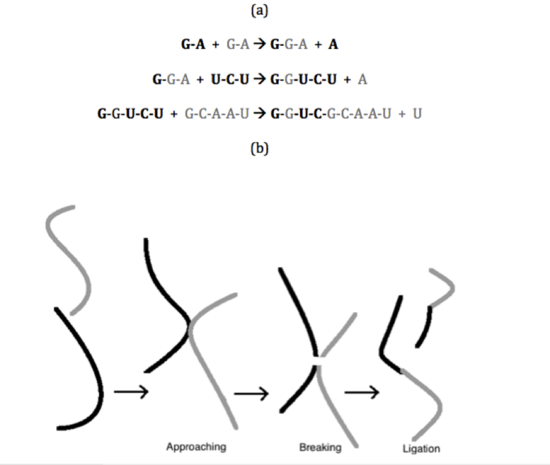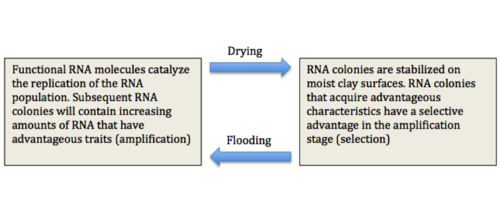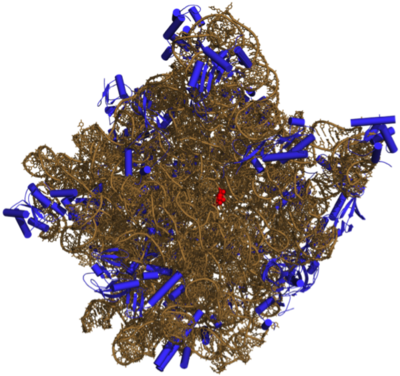User talk:Eric benjamins16
The RNA World Hypothesis is one of the widely accepted theories about the origin of life on earth. The hypothesis proposes that RNA’s intrinsic properties [5] allowed it to replicate and undergo natural selection to generate the protein, DNA, and RNA based lifeforms of modern earth. Since the formulation of the RNA World Hypothesis, research and experiments have been conducted in an attempt to support it. However, there are many seemingly paradoxical and highly improbable circumstances that would need to have occurred for the hypothesis to be valid.
Why RNA?
RNA is able to both store genetic information and perform enzymatic functions. This combination of functions allows RNA to potentially act as a template as well as a catalyst for its own replication, and is one of the primary reasons that RNA is thought to be the original polymer of life [5]. It is hypothesized that RNA used these functions to generate a simple life cycle that then increased in complexity due variation and subsequent natural selection. Eventually, evolution could produce modern life [6]. RNA is expected to have preceded DNA as the original information carrier because it requires less energy to form, and thymine (one of DNA’s possible bases) is formed from a chemical process that utilizes uracil (one of RNA’s possible bases.) DNA cannot catalyze reactions, so it could not have originated and replicated on its own before RNA [3]. Ribonucleotides (not deoxyribonucleotides) are also involved with the supply of energy and catabolism of most living organisms [5]. RNA is expected to have preceded proteins because X-ray calligraphy has shown [3] that RNA catalyzes the synthesis of proteins across all life forms within the ribosome [6]. The proteins of the ribosome appear to function as structural support [3] (Figure 1). DNA and proteins are hypothesized to have been additions to the RNA life system in accordance with reductive evolution of the RNA itself [6].
Major Discoveries Supporting the Hypothesis
Abiotic Formation and Polymerization
The discovery of a reaction that can create ribonucleotides without enzymes was a crucial discovery within the development of the RNA world hypothesis because it provided a possible way that RNA could have formed in an abiotic manner [3]. In addition, “the discovery of non-enzymatic intramolecular (cys) and intermolecular (trans) rearrangements of RNA nucleotide sequences in aqueous solutions in the presence of magnesium ions via spontaneous transesterification reactions” [6] has also provided tremendous support to the RNA World Hypothesis. This phenomenon gives a possible mechanism for the formation of RNA polymers from the oligoribonucleotides that could form on early earth. It also provides a way for there have been variances within these polymers, which would be necessary for natural selection to occur [6]. There are multiple ways that transesterification reactions can occur (Figure 2).

Colony Formation
A second crucial discovery was that RNA could form molecular colonies on moist solid surfaces. In order for RNA to undergo natural selection, a form of compartmentalizing is necessary to create “individuals.” Individualism is important for evolution because there needs to be something that can be selected between, and will not break down once selected for [6].
Natural Selection
These discoveries correspond to the discovery that RNA can be selected for without the necessity of living cells through a repetition of stages of selection and amplification of sequences that perform advantageous functions. For example, if an RNA colony acquired an advantageous trait, such as an affinity for a substance that increases its rate of replication, then it could become amplified within the overall population of RNA (Figure 3) [6].
Problems for the Hypothesis
The Problem with Water
The relationship between RNA and water creates a complex paradox for the RNA world hypothesis. Water is required for the formation of both the double helices of RNA required for reproduction as well as the folded structures of ribozymes. Conversely, is hydrolyzes RNA’s polyribonucleotide chain, terminates the ribose-phosphate backbone, and creates an unstable environment for RNA’s bases in both acidic and alkaline conditions. There have been attempts to explain how the RNA world could avoid the problem with water. One suggestion is that RNA molecules were stabilized on the surface of certain mineral clays. The problem with this suggestion is that the RNA would lose its mobility on the surface of the clays, leading to a reduction in functionality. Certain mineral clays can provide stability to RNA molecules, but they reduce their functionality by reducing their mobility [5]. In order to avoid this problem, there would need to be a cycle that places the RNA molecules on the surface of the clay for stability followed by a release into an aqueous phase to increase functionality (Figure 3). Another suggestion is that water was not the solvent that RNA was able to manifest and evolve in. Formamide is one suggested alternative solvent because RNA is stable within it. Unfortunately, formamide prevents RNA from forming the three dimensional structures, like double helices, that are necessary for the evolution of functional RNA [5]. RNA double helices themselves are stable in water, but there still needs to be stability of the single strands for the progression of the RNA evolution [6].
The Problem with Conformation
The RNA world hypothesis requires the presence of RNA in the conformation of specifically folded single-stranded that can perform various necessary functions. When these functional RNA stands are replicated, they take on the conformation of double stranded helices that are stable due to hydrogen bonding between the strands [6]. In order for the functional RNA stands to continue in the replication process, these double stranded helices must unwind. Unfortunately, to date there has been no definitive explanation that can illuminate how the double stranded helices could be separated into stable single stranded templates for replication without affecting the stability or functionality of the functional RNA strands [5]. One possibility is that RNA was able to form ribozymes that could perform the function of RNA helicases, but this possibility would also leave the folded single stranded ribozymes open to being unwound as well [5]. High-temperature is another possibility because it reduces the stability of the covalent bonds within the double helices. If high-temperature was the cause of the unwinding of RNA double helices, a cycle of “short term periods of heating enabling the unwinding of double-helical replicative intermediates, and further [fixation] of the unfolded single-stranded state upon cooling” [5] would be necessary. Acidification and deionization could also unwind the double helices, but they, like high temperature, affect the covalent bonds of the RNA. One suggestion is that RNA "unwindases" could manifest within the RNA population and free the single strands of RNA by binding to the template strand, (through a thermodynamically favorable conformation) which would cause the hydrogen bonds of binding site to break due to alterations in the structure of the double helix. Many unwindases would need to link-up in succession to free a single strand, and the problem of specificity may still be an issue. If specificity were not an issue, then helicases would work well as the solution to the problem with conformation. A RNA helicase could theoretically fuse with an RNA elongase, combining their functions and creating an RNA polymerase. RNA polymerase is the only known molecule that can copy RNA strands with a high level of specificity, and the formation of one in the RNA world would promote rapid natural selection [6].
The Problem of RNA's Dual Roles
One of the most appealing aspects of the RNA world hypothesis is the ability for RNA to store genetic information and act as a catalyst, which could hypothetically allow it to perform a simple life-like cycle on its own. Catalytic RNA (ribozymes) form as well-folded structures, but this prevents them from acting as genetic templates. Template RNA must remain relatively unfolded in order for it to interact with the components of replication, but unfolded strands lack the necessary structure for the RNA to act as a catalyst. This conflict of structure between the different roles of RNA is one of the primary paradoxes that challenge the RNA world hypothesis. Recently, Ivica et al addressed this paradox by suggesting a way that two RNA strands can perform both processes in a “division of labor.” Previously, it was hypothesized that two complimentary strands could split roles, with one remaining unfolded to act as a template, and one that folds to act as a ribozyme. However, as Ivica et al discuss, there is no reason to assume that the complimentary strand of an RNA sequence that folds well will not also fold itself if the strands are following traditional Watson-Crick base pairing. The suggested method to overcome this problem of symmetry is wobble base pairing between guanine and uracil, which would have a reverse complementary strand that contains an unstable cytosine and adenine pair. Folding simulations displayed that the presence of G:U pairs increases the presence of asymmetric folding sequences. These asymmetric folding sequences can promote a division of RNA functionality because their reverse complements lack stable folding ability, which increases their template ability. In addition, a good template could encode for a ribozyme. Ivica et al supports these ideas with their experimental results [2].
The Problem with Time
The expected ranges of conditions that would have been necessary for the RNA world to exist are specific and very limited. Since it is expected that the RNA world could not exist once microorganisms were present on earth, its origination must have occurred between 4.6-3.6 billion years ago. This time frame is expected to have environmental conditions that would drastically affect RNA’s ability to form and replicate including high temperatures, ultraviolet radiation, and meteorite bombardment. The more intense meteor bombardment of earth occurred until roughly the time-period where the first evidence of cellular life was found to have lived (3.8 billion years ago), and was followed by comets impacting earth. The small differential between the end of the intense meteorite bombardment and the presence of cellular life (which would mean that the evolution of the RNA world would have to occur quite rapidly) has lead to the speculation that life could have originated in space. One possibility is that the meteorite/comet bombardment that ended shortly before the first microbes were thought to exist actually facilitated the origins of life on earth. The comets could have acted as “natural space laboratories” with the water, organic material, absorbent surfaces, and temperature/moisture cycles (due to periods of closeness and distance around the sun during its orbit) thought to be necessary for the evolution of the RNA world. However, this hypothesis has its faults because comets (that we know of) appear to lack the phosphorus, and do not orbit the sun enough to generate enough temperature/moisture cycles necessary to facilitate the RNA world. Another possibility is that the evolution of RNA occurred elsewhere in the universe, and the meteorites brought the ensuing microbial life to earth during the period of intense bombardment. Microbes have displayed the ability to survive in a range of extreme conditions including vacuums and high/low temperatures, so if the origins of life on earth was connected to meteorite bombardment, it is more likely that they could survive the trip than the components of the RNA world. The stability of RNA on its own is dependent on a tight range of limited conditions whereas microbes have added stability due to proteins, repair mechanisms, and a resistant intracellular medium. The idea of microbes arriving on earth on meteorites is supplemented by the analysis of meteorites, which has revealed the presence of organic substances and even potential microfossils [5]. In addition, space flight experiments have been conducted that display the catalytic and protective role of extraterrestrial minerals in the synthesis of nucleotides and peptides [1].
The Problem of Gene Loss
Once evolution reached the stage of protocells composed of RNA, the division of these cells could lead to gene loss without a method of keeping the genes together. In modern cells, the problem of gene loss is solved with chromosomes that can link the genes together. Ma et al suggest that chromosomes developed to solve the problem of gene loss in the ancient RNA world as well. However, as they point out, the idea of a chromosome in the RNA world poses problems. The linkage of genes increases the chances of degradation and incomplete replication, and there would be no governing mechanism to determine the proper starting point for replication. There would also need to be a mechanism to separate functional RNA ribozymes without transcription. The suggested way for chromosomes to avoid these problems is if they are circular and are able to self-cleave. If the chromosome were circular, there would be no risk of degradation starting at the ends of the chromosome, increased template stability, and no problem pertaining to the origin of replication. If there were self-cleaving ribozymes at the sites between genes, then genes with distinct properties may be able to form. Ma et al used a computer simulation to test the hypothesis of circularity and self-cleavage as strategies to overcome apparent problems with chromosomes and found that chromosomes with these characteristics can perform sustained replication [4].
How the RNA World Could Have Progressed
A schema for the RNA world hypothesis could be as follows: First, RNA formed in water that was rich in organic substances on earth or somewhere else in the universe. The RNA molecules began as oligoribonucleotides, but transertification reactions allowed for the formation of polyribonucleotides that could conform into ribozymes. These ribozymes could also act as templates for reproduction due to wobble base pairing. This RNA then manifested on solid moist surfaces (like clay) where it would be able to form stable colonies. These surfaces went through a continuous cycle of flooding and drying to increase functionality of the RNA molecules, while maintaining a stable phase. Within the overall community of RNA, more variation would arise through transesterification reactions. Eventually, the cycle of flooding and drying would lead to selection and amplification of RNA molecules that have advantageous functions (Figure 3). There were not any significant products of the early stages of these cycles until the random generation of a RNA helicase that could break the RNA double helices. The RNA helicase increased the rate of natural selection until the random generation of a RNA polymerase, which subsequently increased the rate of natural selection. Eventually, protocells developed that adapted self-cleaving circular chromosomes for efficient gene transfer. Natural selection continued, and DNA and Proteins supplemented many of the functions of RNA.

Viroids and the RNA World Today
The environment no longer contains free RNA because it would not be able to compete with the modern systems of life in a sufficient way that would allow it to exist. The billions of years of evolutionary improvements to all metabolic and genetic processes would allow microorganisms to overtake any environment the free RNA could thrive in. In addition, microorganisms would be able to use the probable components of the RNA world as substrate. It is also unlikely that fossils from the RNA world will appear in the fossil record. RNA molecules that perform crucial functions within cells, like primer RNAs and telomerase RNA, can be viewed as "relics" from the RNA world [5]. In addition, viroids have been suggested to be relics as well [2]. They are extremely small viral circular single-stranded RNA that sustain life cycles by infecting plants. They replicate through the rolling circle mechanism and rely on the enzymes of the cells they infect for their transcription [2]. The RNA itself does not code for proteins [4]. Their simplicity relates to the notion of RNA with basic life cycles in the RNA world. They also contain some of the mechanisms described previously as potential ways to overcome certain theoretical problems with the RNA world. For example, they contain wobble base G:U pairs that generate a division of labor between asymmetric complimentary strands [2]. They also are models for the potential first chromosome because they have circularity and a cleavage mechanism [4].
References
1. Gontareva, N. B. (12/2013). "Space flight experiments with nonterrestrial minerals and bioorganic molecules". Paleontological journal (0031-0301), 47 (9), p. 1070.
2. Ivica, N A (09/2013). "The paradox of dual roles in the RNA world: resolving the conflict between stable folding and templating ability". Journal of molecular evolution (0022-2844), 77 (3), p. 55.
3. L, Slonczewski, J., Foster, W. Microbiology: An Evolving Science, 3rd Edition. W. W. Norton & Company, 10/2013. VitalBook file.
4. Ma, W (2013). "Circularity and self-cleavage as a strategy for the emergence of a chromosome in the RNA-based protocell". Biology direct (1745-6150), 8 (1), p. 21.
5. Spirin, A. S. (2007). "When, where, and in what environment could the RNA world appear and evolve?". Paleontological journal (0031-0301), 41 (5), p. 481.
6. Spirin, A. S. (12/2013). "The emergence of molecular machines as a prerequisite of the ancient RNA world evolution". Paleontological journal (0031-0301), 47 (9), p. 1016.

